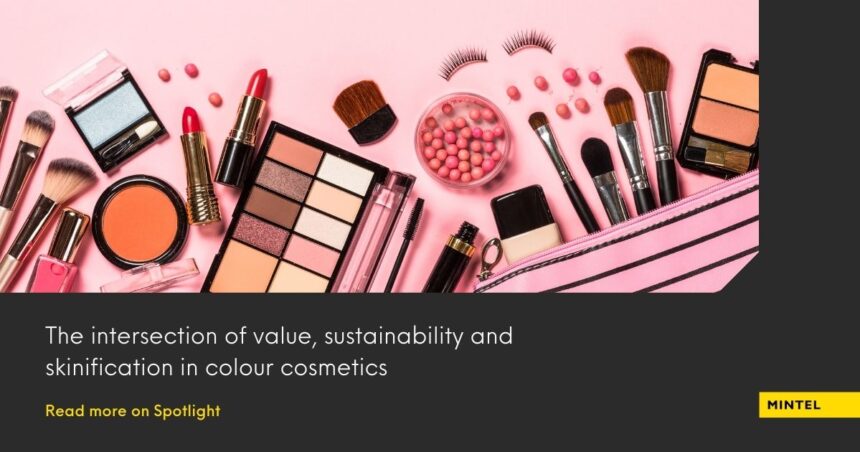The beauty industry has witnessed a wave of innovations in recent years, prompting brands to adapt and cater to consumers’ evolving needs. With the ongoing cost-of-living crisis, value messaging has become crucial, while the concept of “skinification” has significantly influenced new product development (NPD). This integration of skincare-inspired ingredients, trends, and claims into makeup products, known as “hybrids,” has gained significant traction. Additionally, eco-ethical claims continue to be prevalent in the industry.
Among the notable innovations that have emerged in the beauty industry is Sustainable Beauty’s Eclo Eyeshadow with its 100% natural and 0% plastic packaging, using containers made from scrap wood, plants and natural resin. These containers are not only industrially compostable but also 100% biosourced from Europe. Ethique, an Australian sustainable BPC brand, offers a range of seven shades that are palm oil-free, home-compostable, and 100% plastic-free.
Eclo Eyeshadow; Ethique Snapdragron Lipstick. Source: Mintel GNPD
Innovations vary across the regions. In Asia Pacific (APAC), skin benefits and masks drive innovation. New skin-care and makeup products have added benefits such as SPF, hydrating, anti-ageing and anti-acne as skin protection benefits are of high interest to APAC consumers. From 2022 to 2023, 42% of colour cosmetic launches in Asia featured brightening/illuminating claims, while 38% had moisturizing/hydrating claims and 34% had mattifying claims.
Makeup products, in recent years, have included skin-beneficial ingredients, such as collagen, vitamin C, and olive oil. For example, Japan’s Kanebo Cosmetics offers the Lunasol Paradise Lagoon Plump Mellow Lips Satin Lipstick, which contains hyaluronic acid and five botanical oils (olive oil, jojoba oil, almond oil, shea butter, and squalane) for hydration. Maybelline’s FIT Me + Vitamin C x Namito’s Flush Tint, a limited edition launch for Lunar New Year targeting Chinese Gen Z, features vitamin C.
Lunasol Paradise Lagoon Plump Mellow Lips Satin Lipstick; Maybelline’s FIT Me + Vitamin C x Namito’s Flush Tint. Source: Mintel GNPD
Many Asians still wear masks in public, making waterproof makeup claims highly relevant to consumers. Foundations and eyeliners make the highest waterproof/resistant claims, showing a gap for other cosmetics such as blushes and bronzer that may also be affected by mask use.
Cathy Doll Air Relax Lip Blur (Vietnam) is specifically designed to reduce lip friction caused by masks, using amino acids to lock in moisture. Primavista Long-Lasting Face Powder by Kao (Japan) claims to prevent colour transfer onto masks and protect the skin from mask irritation.
Cathy Doll Air Relax Lip Blur; Primavista Long-Lasting Face Powder. Source: Mintel GNPD
In Europe, Middle East, and Africa (EMEA), new product development (NPD) primarily revolves around convenience and eco-packaging. In the Americas, multifunctional products are expected to appeal to consumers amidst the current cost-of-living crisis. Australia and New Zealand (ANZ) highlight natural, sustainable, and native brands as driving forces behind innovation. The ANZ colour cosmetic market witnessed the prevalence of vegan, long-lasting, and brightening claims, along with significant growth in vegan, ethical-animal, and botanical/herbal claims.
Several areas present opportunities for beauty brands to innovate:
- Addressing the cost-of-living crisis: Inflationary pressures are driving value-seeking behaviours to brands that offer attractive incentives like bundling and loyalty programs. Products signify value through convenience claims, so hybrid/multifunctional products appeal to consumers because they believe they save time and money.
- Embracing skin-positive language: As forecast in Mintel’s The Future of Colour Cosmetics: 2021, there has been a backlash against unrealistic beauty standards and brands have needed to adopt skin-positive language and messaging that promotes inclusivity and authenticity.
- Nails as a form of self-expression: Nail colour cosmetics have gained popularity as an outlet for self-expression, accounting for 13% of colour cosmetics launches in 2022.
- Sparking joy with surprising textures: 28% of Thai consumers, in particular, enjoy experimenting with makeup products that offer unique textures, providing an opportunity for brands to introduce innovative formulations.
What we think
There is a stronger focus on mental and skin health so consumers will see a rise of skincare-adjacent claims and a push for evidence of efficacy.
The impacts of climate change and an increase in skin conditions will see a shift in the types of claims consumers are looking for. Brands need to remove barriers and update their products to reflect the market’s changing needs.
Additionally, post-pandemic loneliness has emphasized the importance of community. Beauty brands should strive to foster connections that encourage engagement, both online and in person. Technological advancements will also revolutionize product creation and consumer usage. More brands are expected to engage in community building with consumers, co-developing new products and discussing innovations. Generative AI and technologies like 3D printing and self-monitoring are poised to play significant roles in NPD, allowing brands to recommend and provide the right products at the right time.
If you’re a Mintel client, speak to your Account Manager for access to Mintel’s Year of Innovation global market research. If you’re not a client, visit the Mintel Store to buy the report today, download the free Colour Cosmetics in 2023: Innovation and global trends you have to know report from Mintel and in-cosmetics Asia, or let us know if you’d like to be contacted about scheduling a briefing with a Mintel Beauty and Personal Care Analyst.








